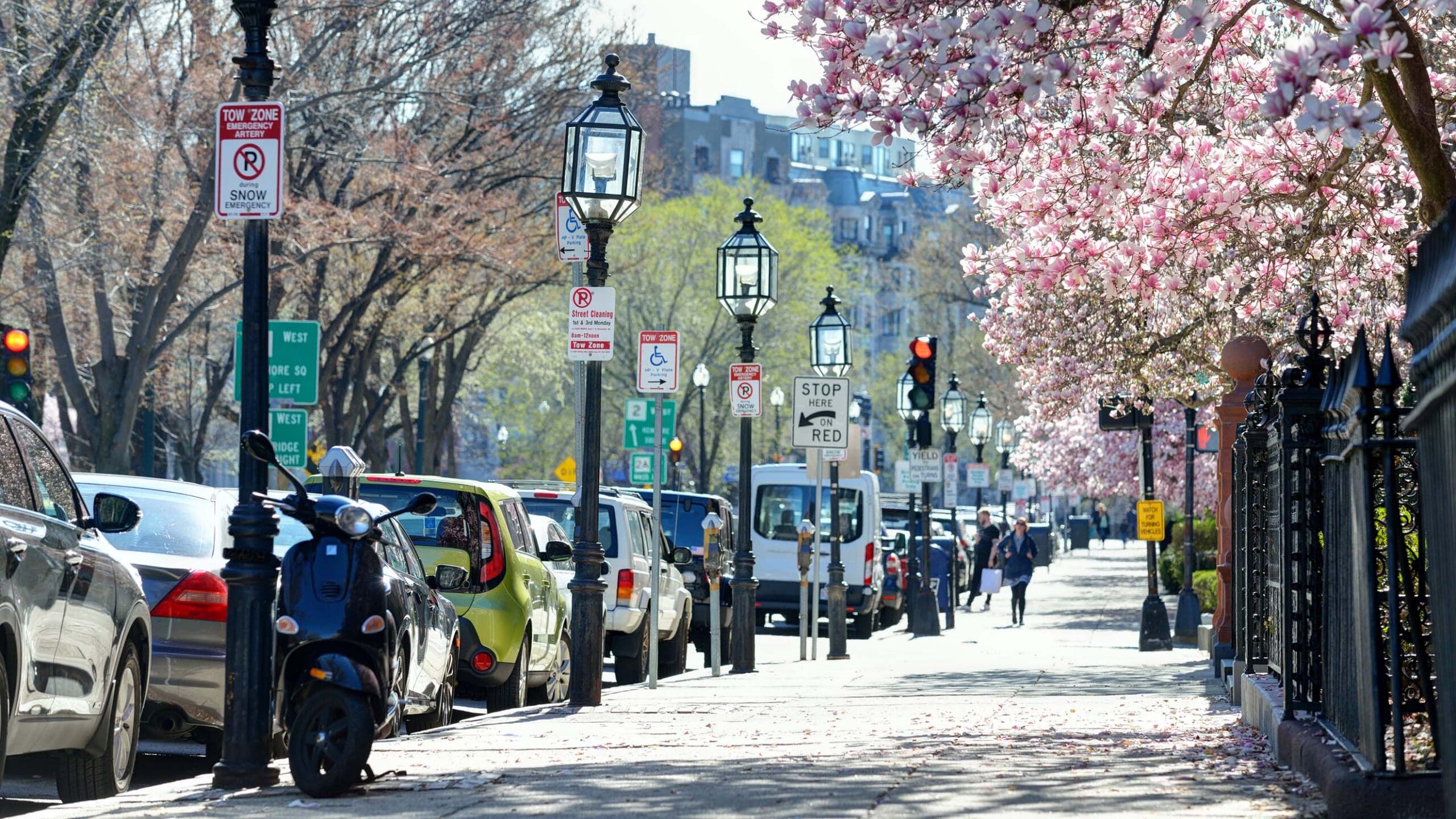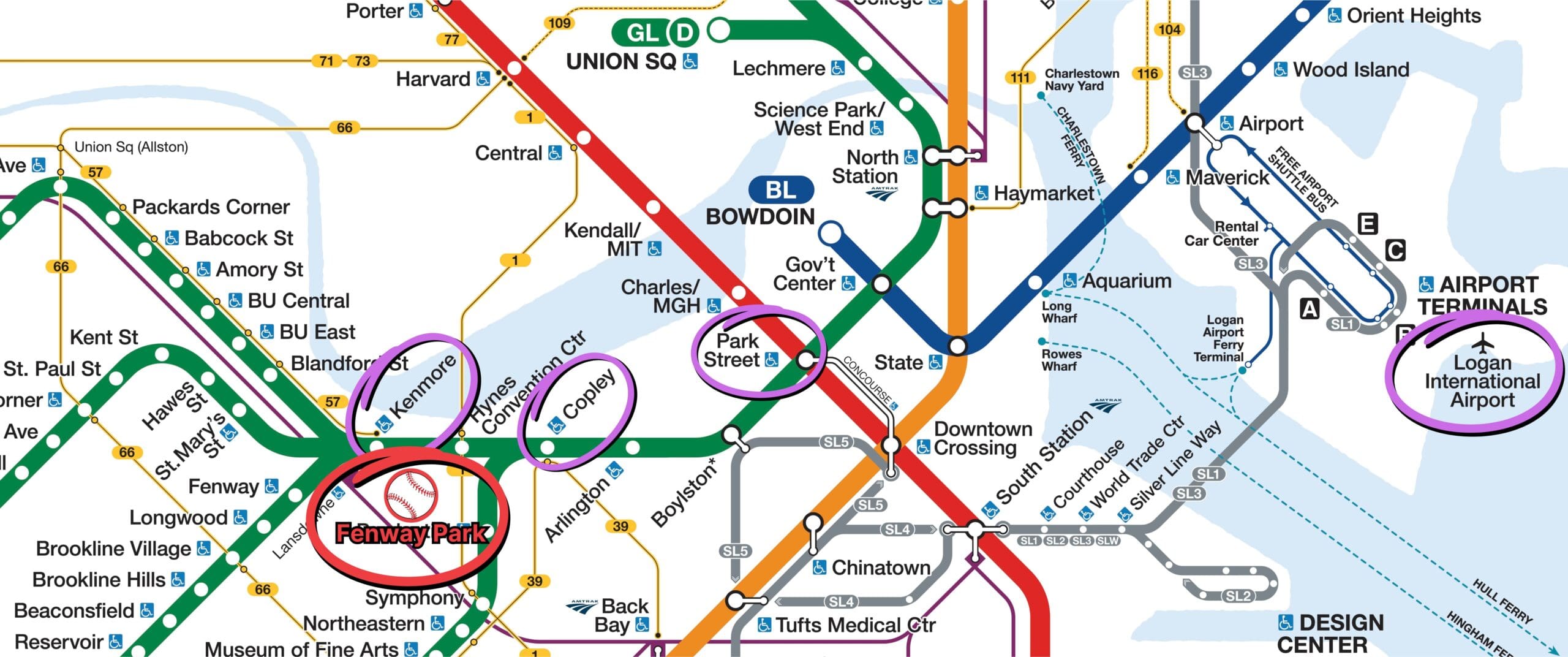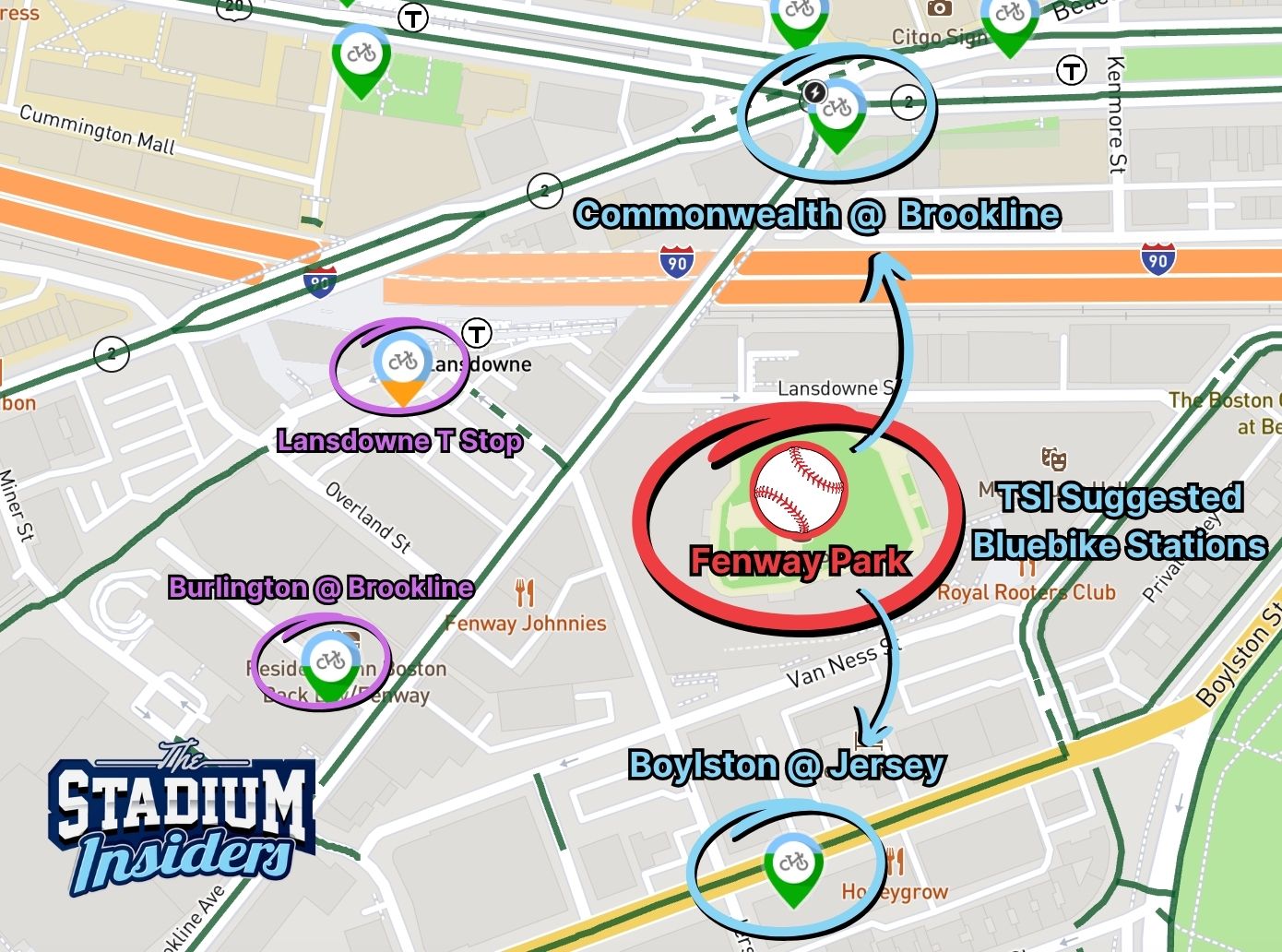How to get to Fenway Park
Boston is the second-smallest major city in the U.S. (behind San Francisco), covering just 48.4 square miles. Much of what we think of as Boston – the historical city, not including the neighborhoods to the south – covers only about a third of that, and anyone wandering around town will find themselves bumping into well-known sights.
It’s very walkable, and if strolling is your thing, you’re in for a treat. A two-and-a-half-mile walk from Faneuil Hall to Fenway could bring you past a 400-year-old burial ground, the State House, Boston Common, the Public Garden, the bar Cheers, the Boston Marathon finish line, and the swanky Newbury Street shopping area. All that in less than an hour on foot.
But there’s no need to wear out your Nikes on a trip to Boston. There are plenty of ways to get around the city, and because it is so compact, they’re all convenient and accessible.
There are five main ways to get to Fenway Park:
How you get to Fenway will depend on what you’re hoping to get out of your trip to Boston (are you there for the Red Sox and Red Sox only, or do you want to soak up some local charm?), where your hotel is located, and how much you and your party are willing to walk or bike. Let’s have a look at the choices.
TSI’s Pick: Ride the Subway

Bostonians love to complain about the T, and if it’s something you’ve got to rely on daily, then service interruptions and track troubles are a longstanding nuisance. But if you’re a tourist, the T (short for MBTA, which is short for Massachusetts Bay Transit Authority) is a godsend.
Like any major city, the train system in Boston can be crowded at peak rush hour times and the underground stations can be grimy, but for the most part, riding the T is safe, pleasant, clean and convenient. It’s $2.40 for a ride and if you anticipate multiple rides, it’s best to load up a card you can hold onto – a Charlie Ticket – so you’re not constantly stopping to pay fares. Be sure to get your bearings, because the direction of trains can be confusing. They’re labeled “inbound” and “outbound” based on whether they’re going toward the city center or away from it.
The T has four lines: Blue, Green, Red and Orange. The Blue Line won’t matter much to visitors, except for airport transit. The Orange and Red lines will require a transfer for you to reach Fenway Park. So let’s start with the Green Line, since it’s the easiest option and the one we expect you’ll be most likely to be using.
Green Line
Connects to Fenway from Copley Square, Back Bay, Theater district, and downtown/Financial district
If you’ve chosen to stay in any of these areas, you’ll have the easiest time getting to Fenway because the Green Line goes directly to the ballpark.
While logic might dictate that you’d get off at the Fenway stop, that’s not the most convenient way to Fenway Park – the stop you want is Kenmore. This is a pretty common mistake, and although it’s likely that you would follow all of the local fans in Sox jerseys getting off the train at Kenmore, we don’t want you to be confused and doubting yourself.
It’s not that you can’t get off at the Fenway station. But it’s the same eight-minute walk to the ballpark from both of these stations, and you’ll get to the Kenmore station first if you’re traveling from east of the ballpark. So continuing on to the Fenway stop will just cost you extra time without any added benefit (unless your destination is the bars/restaurants on the south/southwest side of the ballpark, in which case the Fenway stop will be closer).
Other than that one difference, we should also say that the Green Line can be a little confusing because it has four different endpoints when going to the west of the city, labeled B, C, D, and E. The Green Line E train (labeled Heath Street) is the only one of the four that branches off before you get to Kenmore Square, so do NOT get on that one.
But the B (Boston College), C (Cleveland Circle) and D (Riverside) trains all have Kenmore stops. And if you’ve picked up the Green Line at Copley or Park Street, it’s just two to five sometimes-crowded stops before you exit at Kenmore Square. You can take any of these three lines and you’ll get to Fenway without issue.
When leaving Fenway and going back toward downtown (or to your transfer point at Park Street), expect a wait. The T will speed up service postgame, but there can still be lines throughout the station.
Red Line
Connects to Fenway from: Cambridge (via transfer), South Station (Amtrak, bus, via transfer), Seaport (via transfer)
The Red Line goes from Cambridge in the north to Boston’s distant neighborhoods and suburbs in the south. If you’re staying in Cambridge near the Kendall/MIT, Central, or Harvard stops, the Red Line will take you over the Charles River into Boston, you’ll transfer to the Green Line at Park Street, and from there it’s just five stops to the Kenmore station at Fenway Park. (But FYI – if you’re staying along the river at the Hyatt Regency or Courtyard Marriott in Cambridge, the subway will be too far away to help you – you’ll be relying on rideshares or walking).
The Red Line also has a South Station stop if you’re coming in by bus or Amtrak. If you’re staying in the Seaport area you can either walk or take the Silver Line bus to South Station or to catch the Red Line. Once you’re on the Red Line from South Station, it’s two stops to Park Street, where you’ll transfer to the Green Line for Fenway.
Orange Line
Connects to Fenway from: Theater District, Chinatown (both via transfer)
If your hotel is in the Theater District, the Orange Line might be closest, with nearby stations at Back Bay and Tufts Medical Center. But even in the Theater District, going directly to the Green Line is a better option, with the Boylston or Arlington stations generally within a 10-minute walk.
If you do take the Orange Line, get off at Downtown Crossing and follow signs for the Winter Street Concourse to Park Street station, where you’ll find the Green Line.
Drive (and park)
We’ve cautioned all against the notion of driving to Fenway Park, but if that’s your chosen method, just give yourself enough time to fight traffic. Even with a relatively short distance, you will want to get to the area by 5-5:30 for a 7pm game.
If you’re Zen enough to handle the traffic, your only real problem from there will be parking, and technology has made that easier in recent years. The Red Sox recommend using SpotHero to reserve a parking place, and there are several nearby SpotHero-friendly garages that can accommodate you.
It’s not cheap – reserving a spot near Fenway in advance will get you a parking place in the $50-75 range, but once those spots fill up, prices double and the distances get farther. Our suggestion: book a spot early for the best choice and price.
If you arrive early, you can get a spot across Brookline Street in the Yawkey Parking Lot for $50. Those spots typically fill up and there will be heavy traffic before and after the game. But it is an option.
Driving around the Fenway neighborhood is not easy, not fun, and is really not recommended. The best reason for booking a spot ahead of time on an app is that it will eliminate the need for you to be circling the streets for no good reason. There are no great parking deals to be had near Fenway, so make it easy on yourself: find a spot on an app, book it, drive, park, walk away, and be done with it. Go spend your time enjoying Fenway rather than dealing with parking nonsense.
If you don’t want to use the subway and the prospect of driving in Boston is unappealing, then the way to go is rideshare services like Uber and Lyft, or even taxis – which are competitively priced and can be more convenient in some circumstances. Given Boston’s small size, you can get most anywhere within the city for no more than $25, usually less.
Of course, the issue that arises with crowded events is surge pricing, and that can make your postgame transit considerably more expensive. Your options are to suck it up and accept the steeper surge price, wait a bit for the surge prices to drop with a nightcap or coffee at one of the local bars or restaurants, or walk a bit (east on Commonwealth Ave. to Cafe 472, or around there) to get out of the Fenway surge zone.
The rideshare companies offer what they call “designated” zones for pickup and drop off, but almost no one follows those guidelines. The best place to order and wait for a rideshare is on Boylston Street where, after the game, you’ll see a stretch of fans doing much the same thing, usually in front of the Guitar Center around the corner from Ipswich Street.
There is a taxi stand, too, on Commonwealth Ave. near the Kenmore subway stop.
Bluebikes
These are the city-owned docked bikes that can be picked up and dropped off throughout town, and the price is right – $2.95 for the first 30 minutes and $.25 for each additional minute. Downloading the Bluebikes app and reserving your bike that way is easiest, but single-use passes can be bought at any Bluebikes station using a credit or debit card. You can also get a day pass that will allow for unlimited two-hour rides for just $10.
There are a handful of drop-off stations near Fenway Park, including one in Kenmore Square at the corner of Commonwealth and Brookline Ave. (about a block from the Green Monster), and another at Boylston and Jersey streets (also a block away from the first-base line).
But it’s critical for you to check the Bluebike app to see where there are available spots where you can return your bike. You don’t want to get to Fenway and be stuck with a bike that you can’t get rid of. (And if the app shows that there are no available docks, or if it even looks like the number of docks is very limited, you should definitely avoid taking the bike, as you’ll have to hunt for another available station).
It would not be recommended to take a bike home after a night game, and it certainly would not be recommended to ride through the city without a helmet (and anyone 16 or under is required to have a helmet). Boston has bike lanes, but many of the streets are cramped and not safe for inexperienced riders. But if you’ve got a helmet and you’re confident in your cycling skills, it’s a fun way to arrive at a game.
Check the current Bluebikes location map here to find a nearby station.
Walk

If you’ve got the time, the energy and the comfortable shoes for the job, it’s hard to beat a nice, long pre-game walk through Boston to Fenway. It might be the most walkable major city in the country, and you can come up with any number of themed strolls to the park. Grab a coffee (we prefer Dunkin’ here) and snack your way through the city, put together a pre-game pub crawl, tick off some historical sights, or soak up the city’s architectural highlights. It’s all accessible by foot and if, at any point, you decide to ditch the walk, you can always find the Green Line or a rideshare and be driven the rest of the way.
If you’re starting out at any of the hotel zones we’ve suggested, the walk should be safe, and your phone app can plot out a good route for you.
Bottom Line
Nothing against rental cars and pre-ordered parking spots, but the best thing about getting to a game at Fenway is that Boston is such a small and accessible city that you can keep your options open. Beautiful day? Have a walk. Want to get the feel of the pre-game crowd? Squeeze onto a Green Line train. Feel like lounging at the hotel and arriving at Fenway near game time? Hang out and order a rideshare when you’re ready.
There are some challenges in getting into a Red Sox game — like traveling to Boston and finding tickets — but getting to the park itself is a pleasant experience with plenty of options available.





















